Abstract
The activity of a beta-isoform of phospholipase C (PLC) partially purified from turkey erythrocyte cytosol was assayed using phospholipid monolayers formed at an air-water interface. PLC was rapidly purified at least 8000-fold by a sequence of ion-exchange, hydrophobic and heparin chromatographies. 33P-labelled substrates were prepared using partially purified PtdIns kinase and PtdIns4P 5-kinases, respectively, and purified by h.p.l.c. using an amino-cyano analytical column. Using such 33P-labelled phosphoinositides of high specific radioactivity, PLC activity was monitored directly by measuring the loss of radioactivity from monolayers as a result of the release of inositol phosphates and their subsequent dissolution and quenching in the subphase. Under these conditions, PtdIns4P hydrolysis obeyed approximately first-order kinetics whereas PtdIns(4,5)P2 hydrolysis was zero-order at least until 80% of the substrate had been degraded. PLC activity was markedly affected by the surface pressure of the monolayer, with reduced activity at extremes of initial pressure and with the most permissive pressures in the middle of the range investigated. The optimum surface pressure for hydrolysis of PtdIns4P was approx. 25 mN/m, but for PtdIns(4,5)P2 the maximum activity occurred at the markedly higher surface pressure of 30 mN/m. These data are discussed in terms of the substrate specificity and likely regulation of PLC beta isoforms engaged in degrading their substrate in biological membranes.
Full text
PDF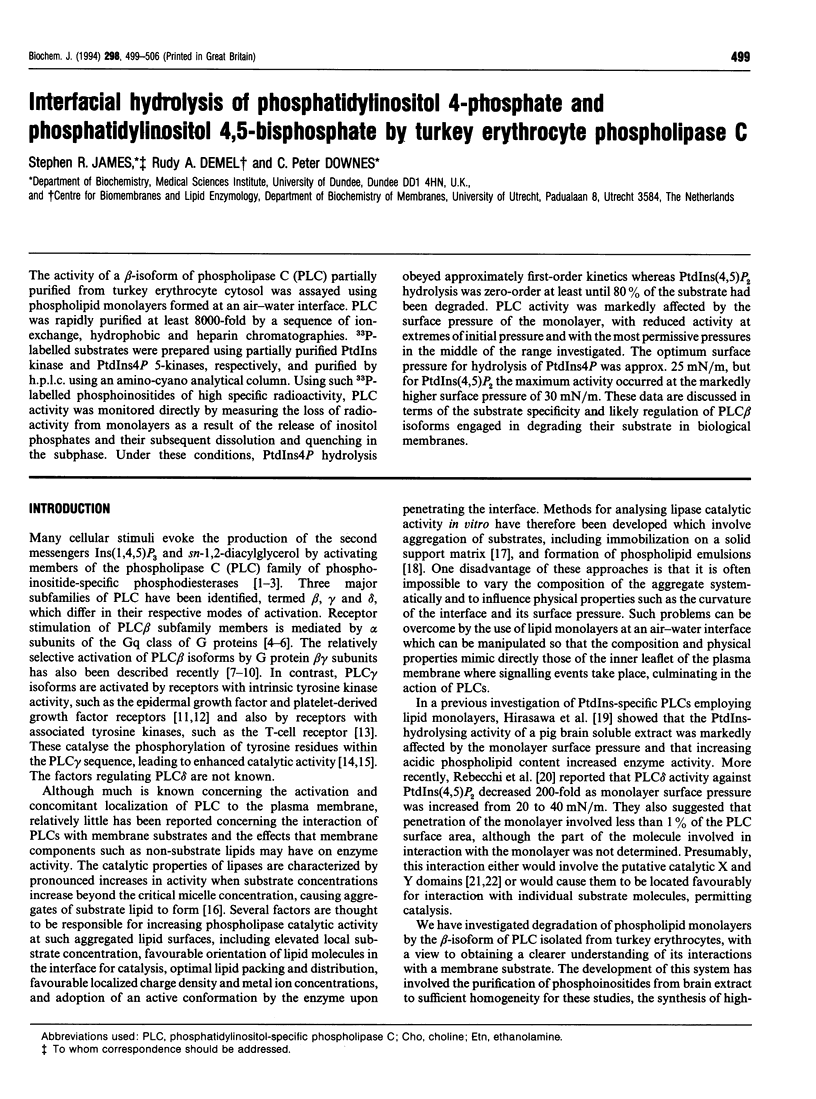
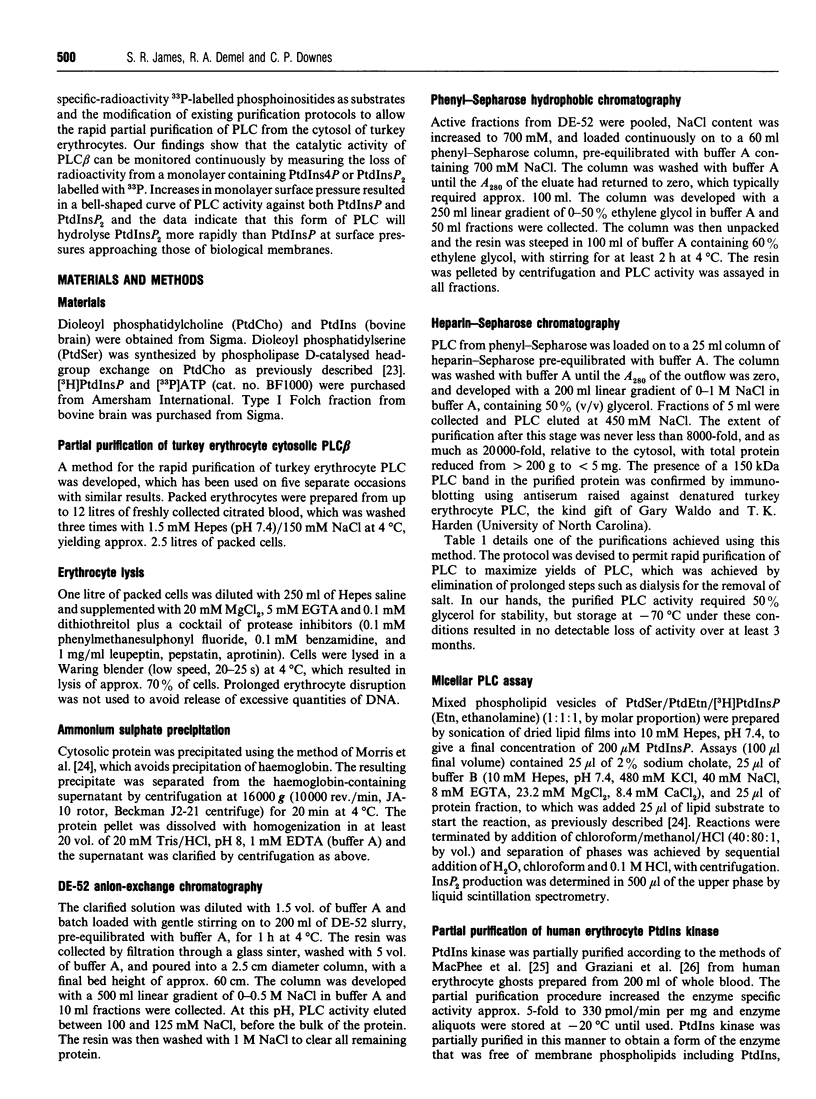
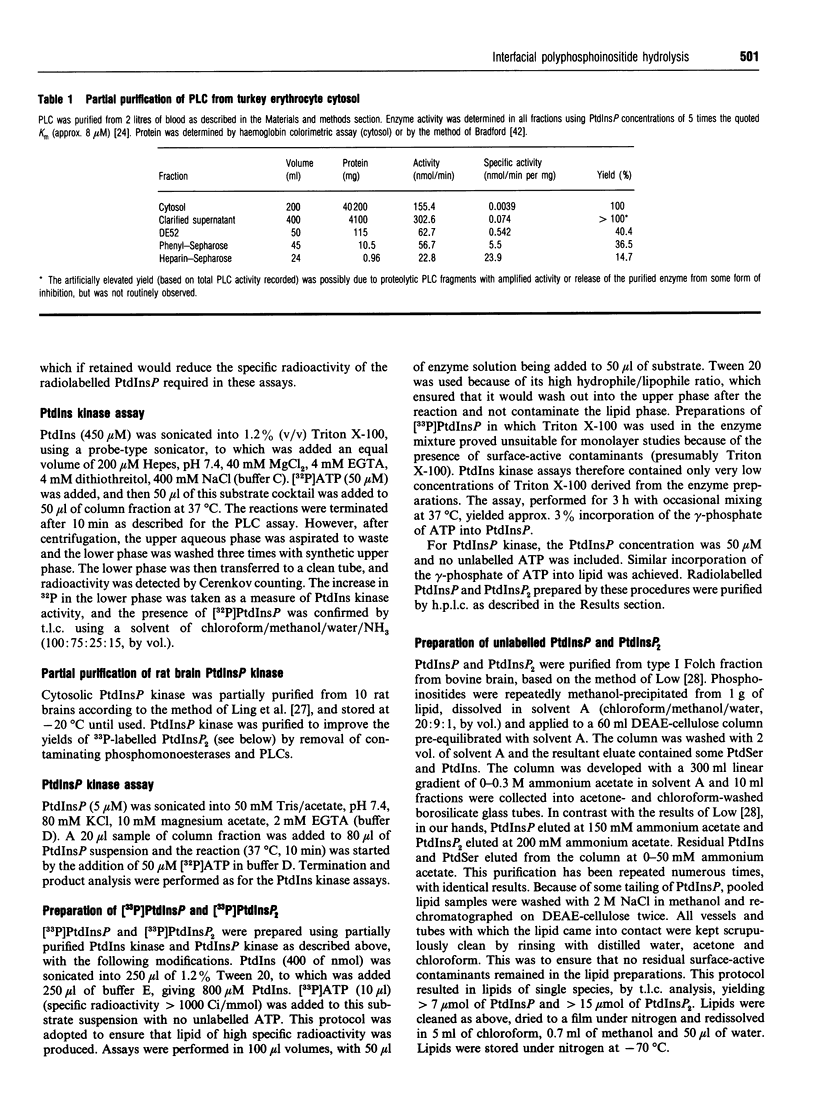
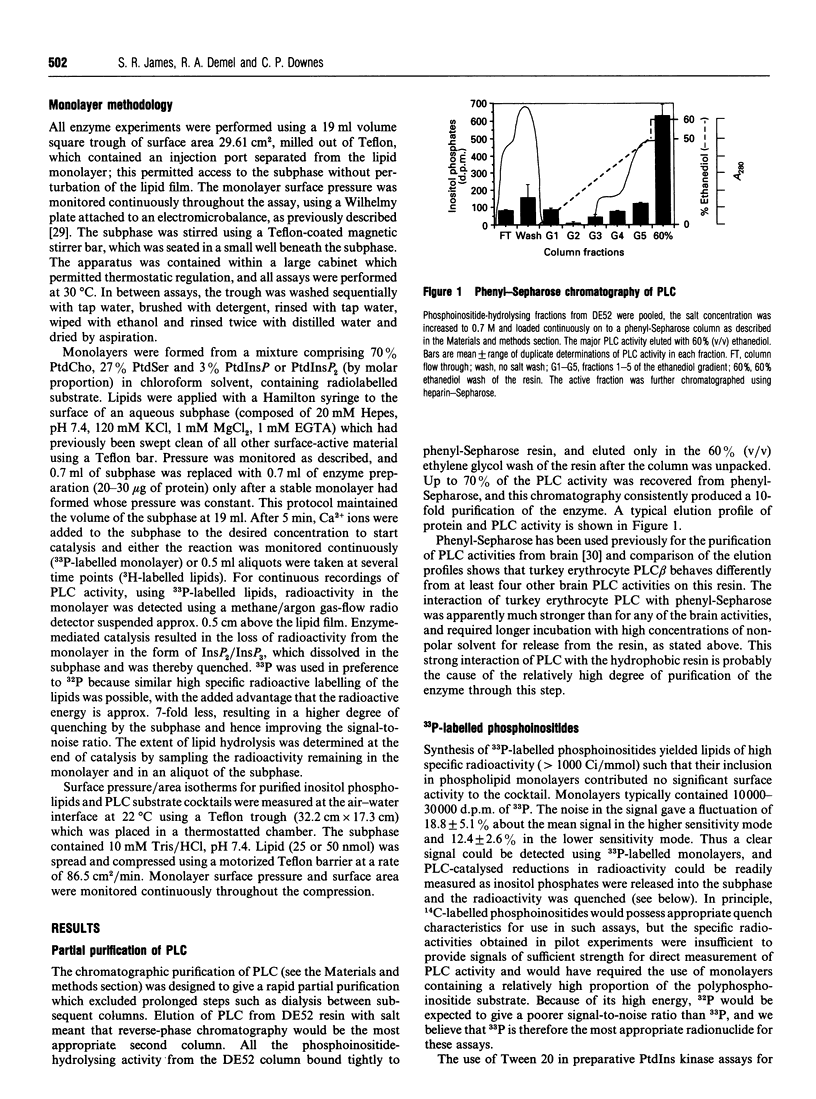
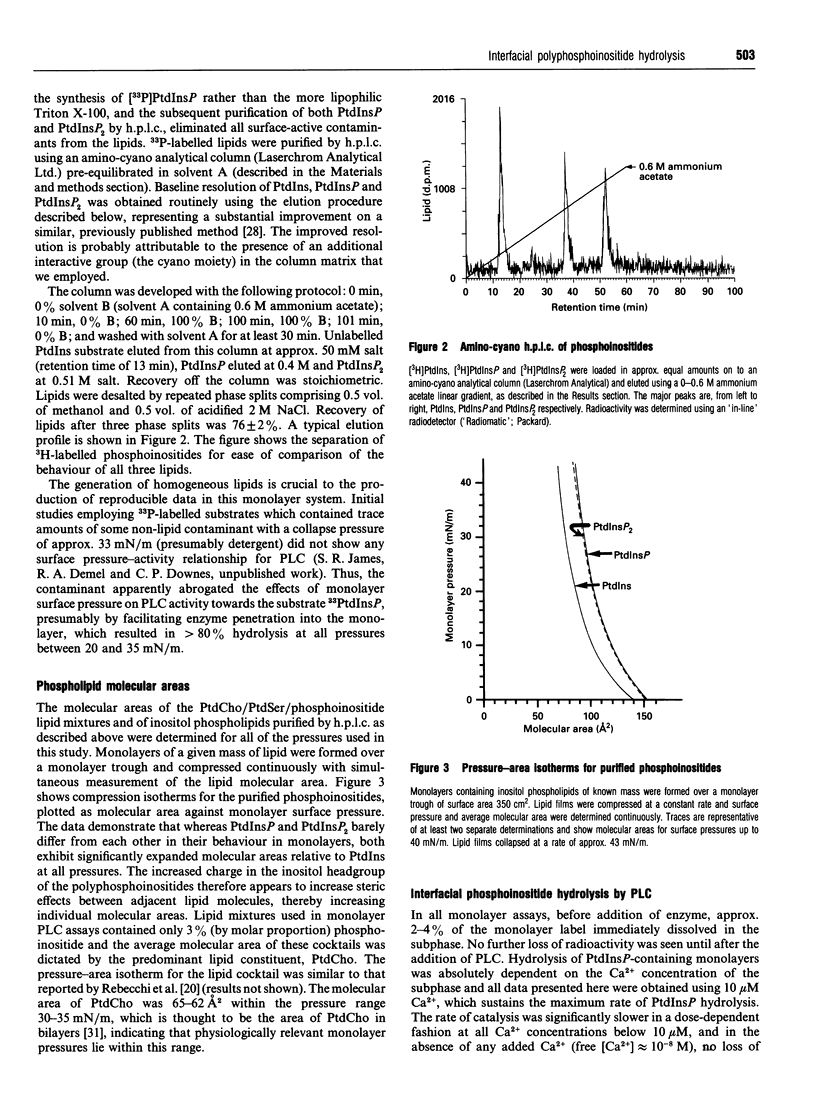

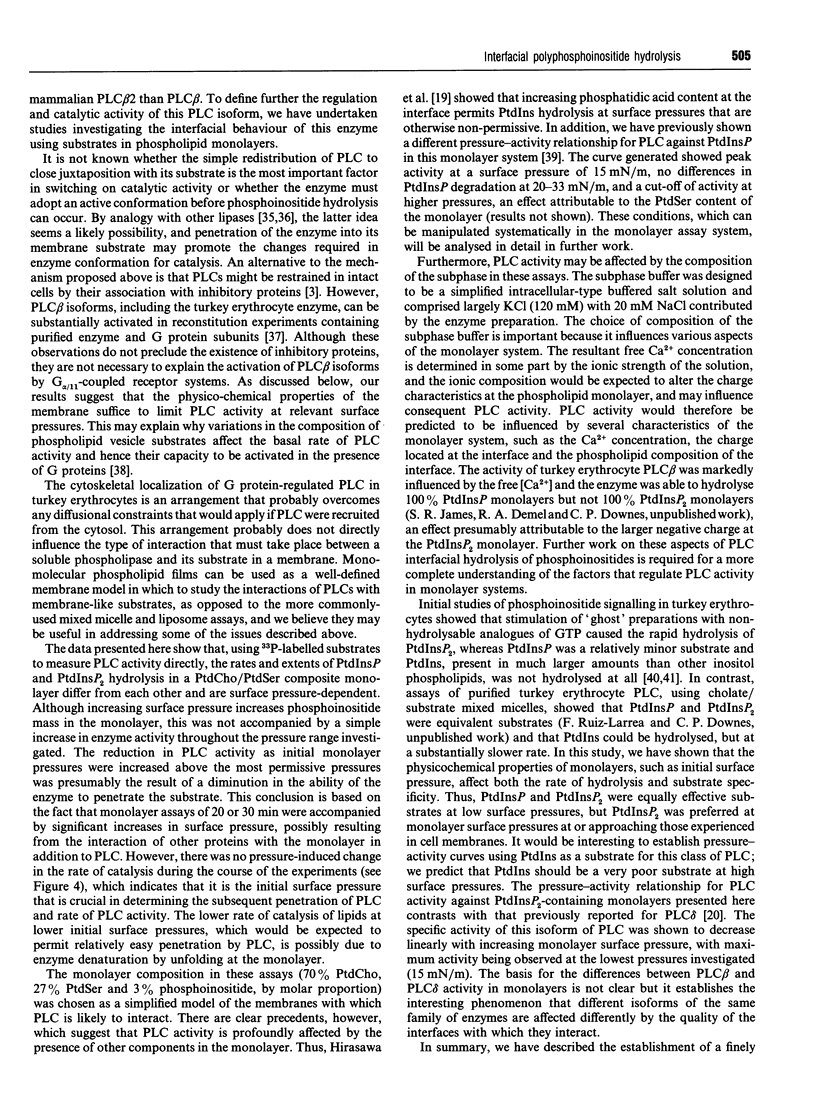
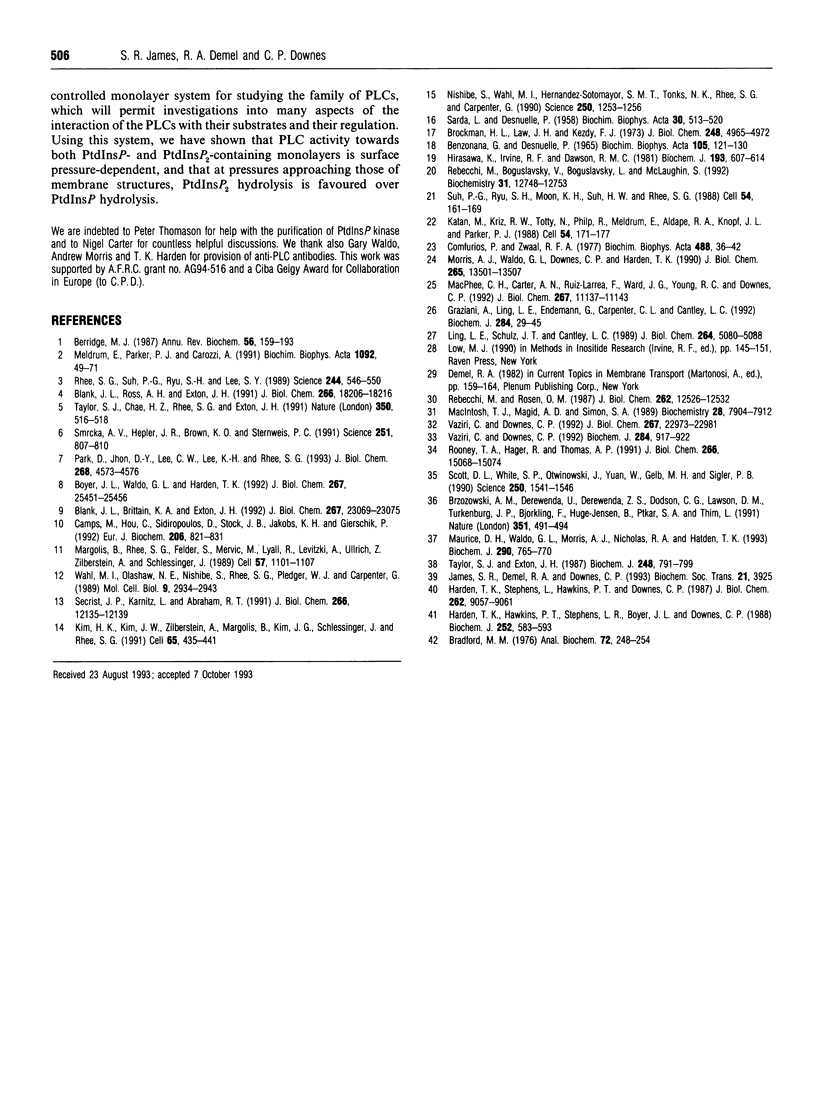
Selected References
These references are in PubMed. This may not be the complete list of references from this article.
- Benzonana G., Desnuelle P. Etude cinétique de l'action de la lipase pancréatique sur des triglycerides en emulsion. Essai d'une enzymologie en milieu hétérogène. Biochim Biophys Acta. 1965 Jul 29;105(1):121–136. [PubMed] [Google Scholar]
- Berridge M. J. Inositol trisphosphate and diacylglycerol: two interacting second messengers. Annu Rev Biochem. 1987;56:159–193. doi: 10.1146/annurev.bi.56.070187.001111. [DOI] [PubMed] [Google Scholar]
- Blank J. L., Brattain K. A., Exton J. H. Activation of cytosolic phosphoinositide phospholipase C by G-protein beta gamma subunits. J Biol Chem. 1992 Nov 15;267(32):23069–23075. [PubMed] [Google Scholar]
- Blank J. L., Ross A. H., Exton J. H. Purification and characterization of two G-proteins that activate the beta 1 isozyme of phosphoinositide-specific phospholipase C. Identification as members of the Gq class. J Biol Chem. 1991 Sep 25;266(27):18206–18216. [PubMed] [Google Scholar]
- Boyer J. L., Waldo G. L., Harden T. K. Beta gamma-subunit activation of G-protein-regulated phospholipase C. J Biol Chem. 1992 Dec 15;267(35):25451–25456. [PubMed] [Google Scholar]
- Bradford M. M. A rapid and sensitive method for the quantitation of microgram quantities of protein utilizing the principle of protein-dye binding. Anal Biochem. 1976 May 7;72:248–254. doi: 10.1016/0003-2697(76)90527-3. [DOI] [PubMed] [Google Scholar]
- Brockman H. L., Law J. H., Kézdy F. J. Catalysis by adsorbed enzymes. The hydrolysis of tripropionin by pancreatic lipase adsorbed to siliconized glass beads. J Biol Chem. 1973 Jul 25;248(14):4965–4970. [PubMed] [Google Scholar]
- Brzozowski A. M., Derewenda U., Derewenda Z. S., Dodson G. G., Lawson D. M., Turkenburg J. P., Bjorkling F., Huge-Jensen B., Patkar S. A., Thim L. A model for interfacial activation in lipases from the structure of a fungal lipase-inhibitor complex. Nature. 1991 Jun 6;351(6326):491–494. doi: 10.1038/351491a0. [DOI] [PubMed] [Google Scholar]
- Camps M., Hou C., Sidiropoulos D., Stock J. B., Jakobs K. H., Gierschik P. Stimulation of phospholipase C by guanine-nucleotide-binding protein beta gamma subunits. Eur J Biochem. 1992 Jun 15;206(3):821–831. doi: 10.1111/j.1432-1033.1992.tb16990.x. [DOI] [PubMed] [Google Scholar]
- Comfurius P., Zwaal R. F. The enzymatic synthesis of phosphatidylserine and purification by CM-cellulose column chromatography. Biochim Biophys Acta. 1977 Jul 20;488(1):36–42. doi: 10.1016/0005-2760(77)90120-5. [DOI] [PubMed] [Google Scholar]
- Graziani A., Ling L. E., Endemann G., Carpenter C. L., Cantley L. C. Purification and characterization of human erythrocyte phosphatidylinositol 4-kinase. Phosphatidylinositol 4-kinase and phosphatidylinositol 3-monophosphate 4-kinase are distinct enzymes. Biochem J. 1992 May 15;284(Pt 1):39–45. doi: 10.1042/bj2840039. [DOI] [PMC free article] [PubMed] [Google Scholar]
- Harden T. K., Hawkins P. T., Stephens L., Boyer J. L., Downes C. P. Phosphoinositide hydrolysis by guanosine 5'-[gamma-thio]triphosphate-activated phospholipase C of turkey erythrocyte membranes. Biochem J. 1988 Jun 1;252(2):583–593. doi: 10.1042/bj2520583. [DOI] [PMC free article] [PubMed] [Google Scholar]
- Harden T. K., Stephens L., Hawkins P. T., Downes C. P. Turkey erythrocyte membranes as a model for regulation of phospholipase C by guanine nucleotides. J Biol Chem. 1987 Jul 5;262(19):9057–9061. [PubMed] [Google Scholar]
- Hirasawa K., Irvine R. F., Dawson R. M. The hydrolysis of phosphatidylinositol monolayers at an air/water interface by the calcium-ion-dependent phosphatidylinositol phosphodiesterase of pig brain. Biochem J. 1981 Feb 1;193(2):607–614. doi: 10.1042/bj1930607. [DOI] [PMC free article] [PubMed] [Google Scholar]
- Katan M., Kriz R. W., Totty N., Philp R., Meldrum E., Aldape R. A., Knopf J. L., Parker P. J. Determination of the primary structure of PLC-154 demonstrates diversity of phosphoinositide-specific phospholipase C activities. Cell. 1988 Jul 15;54(2):171–177. doi: 10.1016/0092-8674(88)90549-1. [DOI] [PubMed] [Google Scholar]
- Kim H. K., Kim J. W., Zilberstein A., Margolis B., Kim J. G., Schlessinger J., Rhee S. G. PDGF stimulation of inositol phospholipid hydrolysis requires PLC-gamma 1 phosphorylation on tyrosine residues 783 and 1254. Cell. 1991 May 3;65(3):435–441. doi: 10.1016/0092-8674(91)90461-7. [DOI] [PubMed] [Google Scholar]
- Ling L. E., Schulz J. T., Cantley L. C. Characterization and purification of membrane-associated phosphatidylinositol-4-phosphate kinase from human red blood cells. J Biol Chem. 1989 Mar 25;264(9):5080–5088. [PubMed] [Google Scholar]
- Macphee C. H., Carter A. N., Ruiz-Larrea F., Ward J. G., Young R. C., Downes C. P. The stereoselective recognition of substrates by phosphoinositide kinases. Studies using synthetic stereoisomers of dipalmitoyl phosphatidylinositol. J Biol Chem. 1992 Jun 5;267(16):11137–11143. [PubMed] [Google Scholar]
- Margolis B., Rhee S. G., Felder S., Mervic M., Lyall R., Levitzki A., Ullrich A., Zilberstein A., Schlessinger J. EGF induces tyrosine phosphorylation of phospholipase C-II: a potential mechanism for EGF receptor signaling. Cell. 1989 Jun 30;57(7):1101–1107. doi: 10.1016/0092-8674(89)90047-0. [DOI] [PubMed] [Google Scholar]
- Maurice D. H., Waldo G. L., Morris A. J., Nicholas R. A., Harden T. K. Identification of G alpha 11 as the phospholipase C-activating G-protein of turkey erythrocytes. Biochem J. 1993 Mar 15;290(Pt 3):765–770. doi: 10.1042/bj2900765. [DOI] [PMC free article] [PubMed] [Google Scholar]
- McIntosh T. J., Magid A. D., Simon S. A. Range of the solvation pressure between lipid membranes: dependence on the packing density of solvent molecules. Biochemistry. 1989 Sep 19;28(19):7904–7912. doi: 10.1021/bi00445a053. [DOI] [PubMed] [Google Scholar]
- Meldrum E., Parker P. J., Carozzi A. The PtdIns-PLC superfamily and signal transduction. Biochim Biophys Acta. 1991 Mar 19;1092(1):49–71. doi: 10.1016/0167-4889(91)90177-y. [DOI] [PubMed] [Google Scholar]
- Morris A. J., Waldo G. L., Downes C. P., Harden T. K. A receptor and G-protein-regulated polyphosphoinositide-specific phospholipase C from turkey erythrocytes. I. Purification and properties. J Biol Chem. 1990 Aug 15;265(23):13501–13507. [PubMed] [Google Scholar]
- Nishibe S., Wahl M. I., Hernández-Sotomayor S. M., Tonks N. K., Rhee S. G., Carpenter G. Increase of the catalytic activity of phospholipase C-gamma 1 by tyrosine phosphorylation. Science. 1990 Nov 30;250(4985):1253–1256. doi: 10.1126/science.1700866. [DOI] [PubMed] [Google Scholar]
- Park D., Jhon D. Y., Lee C. W., Lee K. H., Rhee S. G. Activation of phospholipase C isozymes by G protein beta gamma subunits. J Biol Chem. 1993 Mar 5;268(7):4573–4576. [PubMed] [Google Scholar]
- Rebecchi M. J., Rosen O. M. Purification of a phosphoinositide-specific phospholipase C from bovine brain. J Biol Chem. 1987 Sep 15;262(26):12526–12532. [PubMed] [Google Scholar]
- Rebecchi M., Boguslavsky V., Boguslavsky L., McLaughlin S. Phosphoinositide-specific phospholipase C-delta 1: effect of monolayer surface pressure and electrostatic surface potentials on activity. Biochemistry. 1992 Dec 29;31(51):12748–12753. doi: 10.1021/bi00166a006. [DOI] [PubMed] [Google Scholar]
- Rhee S. G., Suh P. G., Ryu S. H., Lee S. Y. Studies of inositol phospholipid-specific phospholipase C. Science. 1989 May 5;244(4904):546–550. doi: 10.1126/science.2541501. [DOI] [PubMed] [Google Scholar]
- Rooney T. A., Hager R., Thomas A. P. Beta-adrenergic receptor-mediated phospholipase C activation independent of cAMP formation in turkey erythrocyte membranes. J Biol Chem. 1991 Aug 15;266(23):15068–15074. [PubMed] [Google Scholar]
- SARDA L., DESNUELLE P. Action de la lipase pancréatique sur les esters en émulsion. Biochim Biophys Acta. 1958 Dec;30(3):513–521. doi: 10.1016/0006-3002(58)90097-0. [DOI] [PubMed] [Google Scholar]
- Scott D. L., White S. P., Otwinowski Z., Yuan W., Gelb M. H., Sigler P. B. Interfacial catalysis: the mechanism of phospholipase A2. Science. 1990 Dec 14;250(4987):1541–1546. doi: 10.1126/science.2274785. [DOI] [PMC free article] [PubMed] [Google Scholar]
- Secrist J. P., Karnitz L., Abraham R. T. T-cell antigen receptor ligation induces tyrosine phosphorylation of phospholipase C-gamma 1. J Biol Chem. 1991 Jul 5;266(19):12135–12139. [PubMed] [Google Scholar]
- Smrcka A. V., Hepler J. R., Brown K. O., Sternweis P. C. Regulation of polyphosphoinositide-specific phospholipase C activity by purified Gq. Science. 1991 Feb 15;251(4995):804–807. doi: 10.1126/science.1846707. [DOI] [PubMed] [Google Scholar]
- Suh P. G., Ryu S. H., Moon K. H., Suh H. W., Rhee S. G. Cloning and sequence of multiple forms of phospholipase C. Cell. 1988 Jul 15;54(2):161–169. doi: 10.1016/0092-8674(88)90548-x. [DOI] [PubMed] [Google Scholar]
- Taylor S. J., Chae H. Z., Rhee S. G., Exton J. H. Activation of the beta 1 isozyme of phospholipase C by alpha subunits of the Gq class of G proteins. Nature. 1991 Apr 11;350(6318):516–518. doi: 10.1038/350516a0. [DOI] [PubMed] [Google Scholar]
- Taylor S. J., Exton J. H. Guanine-nucleotide and hormone regulation of polyphosphoinositide phospholipase C activity of rat liver plasma membranes. Bivalent-cation and phospholipid requirements. Biochem J. 1987 Dec 15;248(3):791–799. doi: 10.1042/bj2480791. [DOI] [PMC free article] [PubMed] [Google Scholar]
- Vaziri C., Downes C. P. Association of a receptor and G-protein-regulated phospholipase C with the cytoskeleton. J Biol Chem. 1992 Nov 15;267(32):22973–22981. [PubMed] [Google Scholar]
- Vaziri C., Downes C. P. G-protein-mediated activation of turkey erythrocyte phospholipase C by beta-adrenergic and P2y-purinergic receptors. Biochem J. 1992 Jun 15;284(Pt 3):917–922. doi: 10.1042/bj2840917. [DOI] [PMC free article] [PubMed] [Google Scholar]
- Wahl M. I., Olashaw N. E., Nishibe S., Rhee S. G., Pledger W. J., Carpenter G. Platelet-derived growth factor induces rapid and sustained tyrosine phosphorylation of phospholipase C-gamma in quiescent BALB/c 3T3 cells. Mol Cell Biol. 1989 Jul;9(7):2934–2943. doi: 10.1128/mcb.9.7.2934. [DOI] [PMC free article] [PubMed] [Google Scholar]


